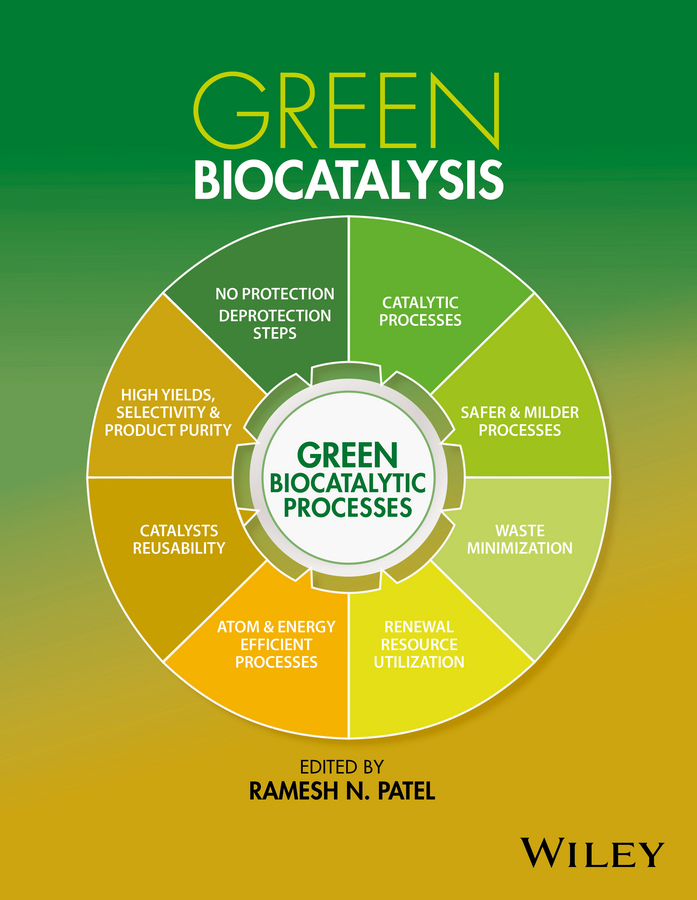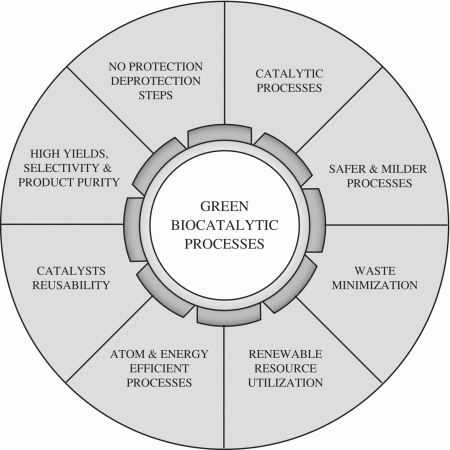
Table of Contents
List of Tables
- Chapter 01
- Chapter 02
- Chapter 03
- Chapter 06
- Chapter 07
- Chapter 08
- Chapter 09
- Chapter 10
- Chapter 11
- Chapter 12
- Chapter 13
- Chapter 15
- Chapter 16
- Chapter 17
- Chapter 18
- Chapter 19
- Chapter 20
- Chapter 22
- Chapter 23
- Chapter 25
- Chapter 27
- Chapter 28
- Chapter 29
List of Illustrations
- Chapter 01
- Chapter 02
- Chapter 03
- Chapter 04
- Chapter 05
- Chapter 06
- Chapter 07
- Chapter 08
- Chapter 09
- Chapter 10
- Chapter 11
- Chapter 12
- Chapter 13
- Chapter 14
- Chapter 15
- Chapter 16
- Chapter 17
- Chapter 18
- Chapter 19
- Chapter 20
- Chapter 21
- Chapter 22
- Chapter 23
- Chapter 24
- Chapter 25
- Chapter 26
- Chapter 27
- Chapter 28
- Chapter 29
Guide
Pages
GREEN BIOCATALYSIS
Edited by
Ramesh N. Patel

Copyright 2016 by John Wiley & Sons, Inc. All rights reserved
Published by John Wiley & Sons, Inc., Hoboken, New Jersey
Published simultaneously in Canada
No part of this publication may be reproduced, stored in a retrieval system, or transmitted in any form or by any means, electronic, mechanical, photocopying, recording, scanning, or otherwise, except as permitted under Section 107 or 108 of the 1976 United States Copyright Act, without either the prior written permission of the Publisher, or authorization through payment of the appropriate per-copy fee to the Copyright Clearance Center, Inc., 222 Rosewood Drive, Danvers, MA 01923, (978) 750-8400, fax (978) 750-4470, or on the web at www.copyright.com. Requests to the Publisher for permission should be addressed to the Permissions Department, John Wiley & Sons, Inc., 111 River Street, Hoboken, NJ 07030, (201) 748-6011, fax (201) 748-6008, or online at http://www.wiley.com/go/permissions.
Limit of Liability/Disclaimer of Warranty: While the publisher and author have used their best efforts in preparing this book, they make no representations or warranties with respect to the accuracy or completeness of the contents of this book and specifically disclaim any implied warranties of merchantability or fitness for a particular purpose. No warranty may be created or extended by sales representatives or written sales materials. The advice and strategies contained herein may not be suitable for your situation. You should consult with a professional where appropriate. Neither the publisher nor author shall be liable for any loss of profit or any other commercial damages, including but not limited to special, incidental, consequential, or other damages.
For general information on our other products and services or for technical support, please contact our Customer Care Department within the United States at (800) 762-2974, outside the United States at (317) 572-3993 or fax (317) 572-4002.
Wiley also publishes its books in a variety of electronic formats. Some content that appears in print may not be available in electronic formats. For more information about Wiley products, visit our web site at www.wiley.com.
Library of Congress Cataloging-in-Publication Data:
Names: Patel, Ramesh N., 1942
Title: Green biocatalysis / edited by Ramesh N. Patel.
Description: Hoboken, New Jersey : John Wiley & Sons, Inc., 2016. | Includes bibliographical references and index.
Identifiers: LCCN 2015047535 (print) | LCCN 2015047720 (ebook) | ISBN 9781118822296 (hardback) | ISBN 9781118822357 (pdf) | ISBN 9781118822364 (epub)
Subjects: LCSH: EnzymesBiotechnology. | Biocatalysis. | Green chemistry. |BISAC: TECHNOLOGY & ENGINEERING / Chemical & Biochemical.
Classification: LCC TP248.65.E59 G735 2016 (print) | LCC TP248.65.E59 (ebook) | DDC 660dc23
LC record available at http://lccn.loc.gov/2015047535
Cover image courtesy of Wiley
Preface
Microorganisms, and biocatalysts derived from them, have enormous potential for carrying out the conversion of a variety of synthetic chemicals to useful products in a highly chemoselective, enantioselective, and regioselective manner. Green biocatalysis provides a technology that uses milder and safer processes. Bioprocesses are carried out under ambient temperature and atmospheric pressure in aqueous conditions, which do not cause any racemization, epimerization, or rearrangement of compounds and thus avoid any protection and deprotection steps during synthesis and shorten the synthetic processes. It prevents, eliminates, or minimizes waste rather than offering waste remediation. Green biocatalysis also uses renewable resources and less hazardous materials than chemical processes. Advances in directed evolution under process conditions have provided novel, efficient, and stable biocatalysts for the development of efficient and economical processes under desired operational conditions. One can achieve sustainable development goals using green biocatalytic processes.
Demand for chiral compounds continues to increase, mainly for use in pharmaceuticals but also in other industries such as flavor, fragrance, cosmetics, and agricultural chemicals. Chiral active pharmaceutical ingredients (APIs) were previously usually formulated as racemates; the preference now is for single enantiomers. The switch from a racemic compound to a single enantiomer of API is required to extend life-cycle management and also to improve the bioavailability and efficacy of drugs.
Since the mid-2000s, progress in the high-level expression of enzymes, in Escherichia coli, Pichia pastoris, and other microbial systems, and improvement in fermentation technology has led to an increase in cell yields in a much shorter time. Advances in protein purification technology, determination of the structure of proteins along with molecular cloning, and the random and directed evolution of biocatalysts have opened up unlimited access to a variety of efficient enzymes and microbial cultures as tools in organic synthesis. The development of efficient immobilization techniques for biocatalysts and the reusability of biocatalysts have provided highly economical and energy-efficient processes for the synthesis of key intermediates and drug products in the pharmaceutical, agrochemical, flavor, fragrance, cosmetics, and pesticide industries.
Various chapters in this book are contributed by internationally renowned scientists and professors from industry and from well known universities, with many years of experience in the design and development of green processes and the industrial application of various processes in the production of fine chemicals and pharmaceuticals. The book contains 29 chapters with over 3000 references and more than 700 equations, drawings, and tables. It examines the use of a variety of classes of enzymes in the development of green processes to generate chiral compounds useful in chemoenzymatic synthesis of drug and agricultural products, cosmetics, and flavor compounds. All the chapters are well presented and cover the following key aspects of biocatalysis:
Next page












